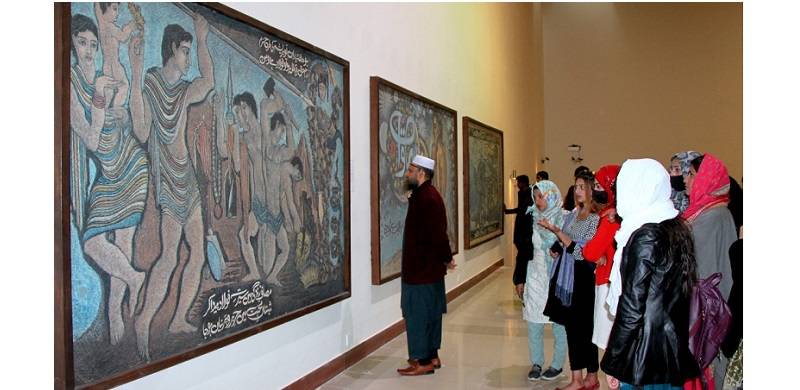
Sadequain was an iconic cult persona of his time. His symbols are blatant like his poetry. He was a master calligrapher, painter, poet and ambassador of Pakistan in the world. He raised the art of classical calligraphy to new form and heights.
This was the gist of the speeches that were made by participants at an event featuring the launch of a book from the sketchbook of Sadequain, an exhibition of his paintings and calligraphy titled "Mystic Expressions” and the screening of a docu-film Raaz-e-Fun on the life and achievements of the legendary artist.
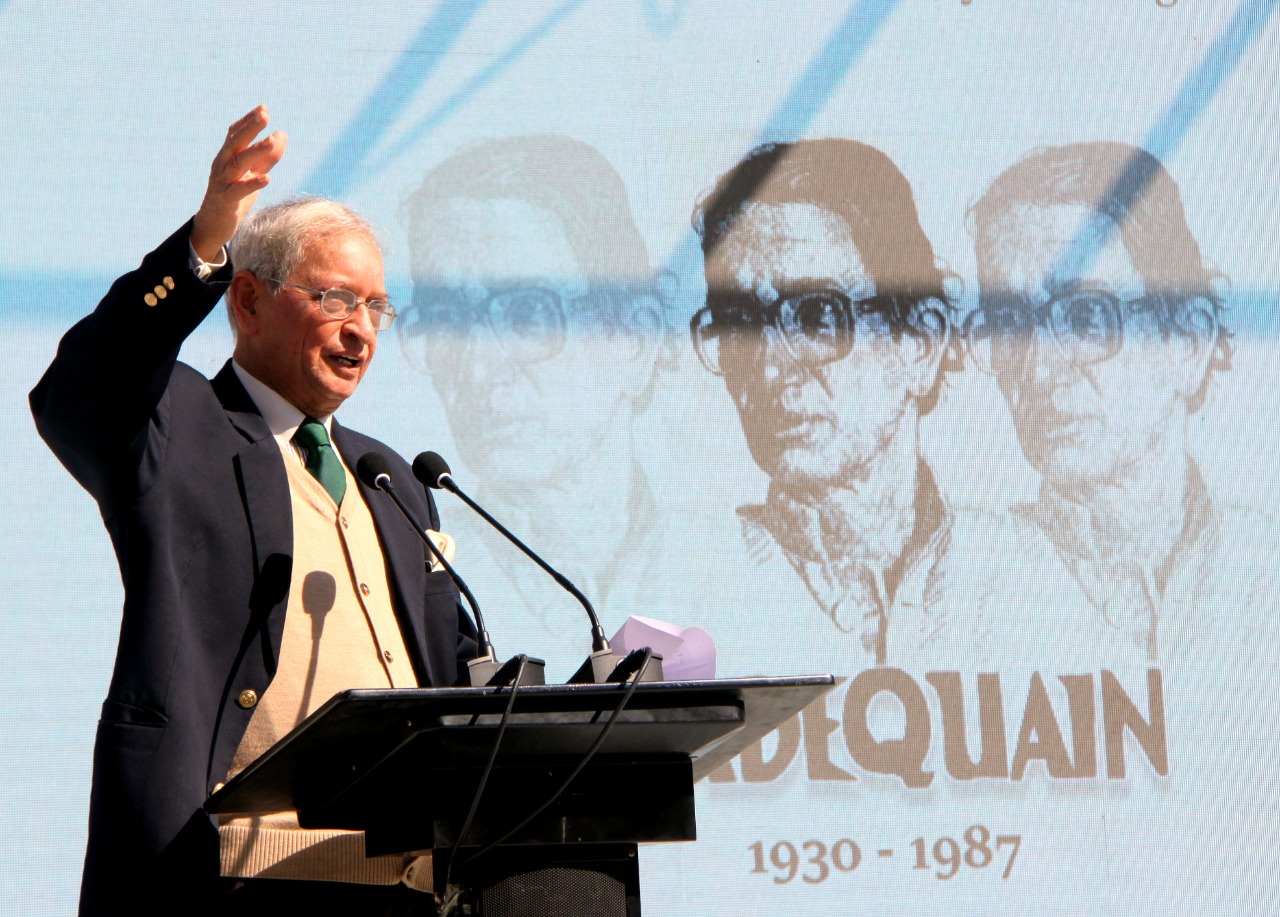 The event was organised by the Pakistan National Council of the Arts (PNCA) in collaboration with the Sadequain Foundation on his 35th anniversary on Thursday.
The event was organised by the Pakistan National Council of the Arts (PNCA) in collaboration with the Sadequain Foundation on his 35th anniversary on Thursday.
Minister of State and BoI Chairman Zafar Ahsan opened the show along with former Ambassador Sarwar Naqvi and Professor Dr Maimoona Khan.
Ali Sarwar Naqvi, a former Ambassador to the US and currently working as the founding executive director of the Centre for International Studies, highlighted the artist’s greatness and achievements. He recalled his fond memories when he met the artist as a student at Karachi in the late 1960s.
He described Sadequain as an icon, a cult personage who has a devoted following even today and will continue to have for years to come.
“He lives in our memories and in our thoughts,” said Mr Naqvi.
Sadequain was the most prolific painter and poet of his time. He was compared to Picasso for the versatility and vigour of his artistic genius and to Michelangelo for his gigantic murals displayed on many public buildings. No other Pakistani artist has created such huge murals. “Like Picasso, Sadequain had a signature to his arts. He was much decorated and honoured in Pakistan and abroad,” veteran diplomat Mr. Naqvi noted. “He was such a master of the traditional art of calligraphy that he raised to an art form of his own style. Unlike many other painters and calligraphers.”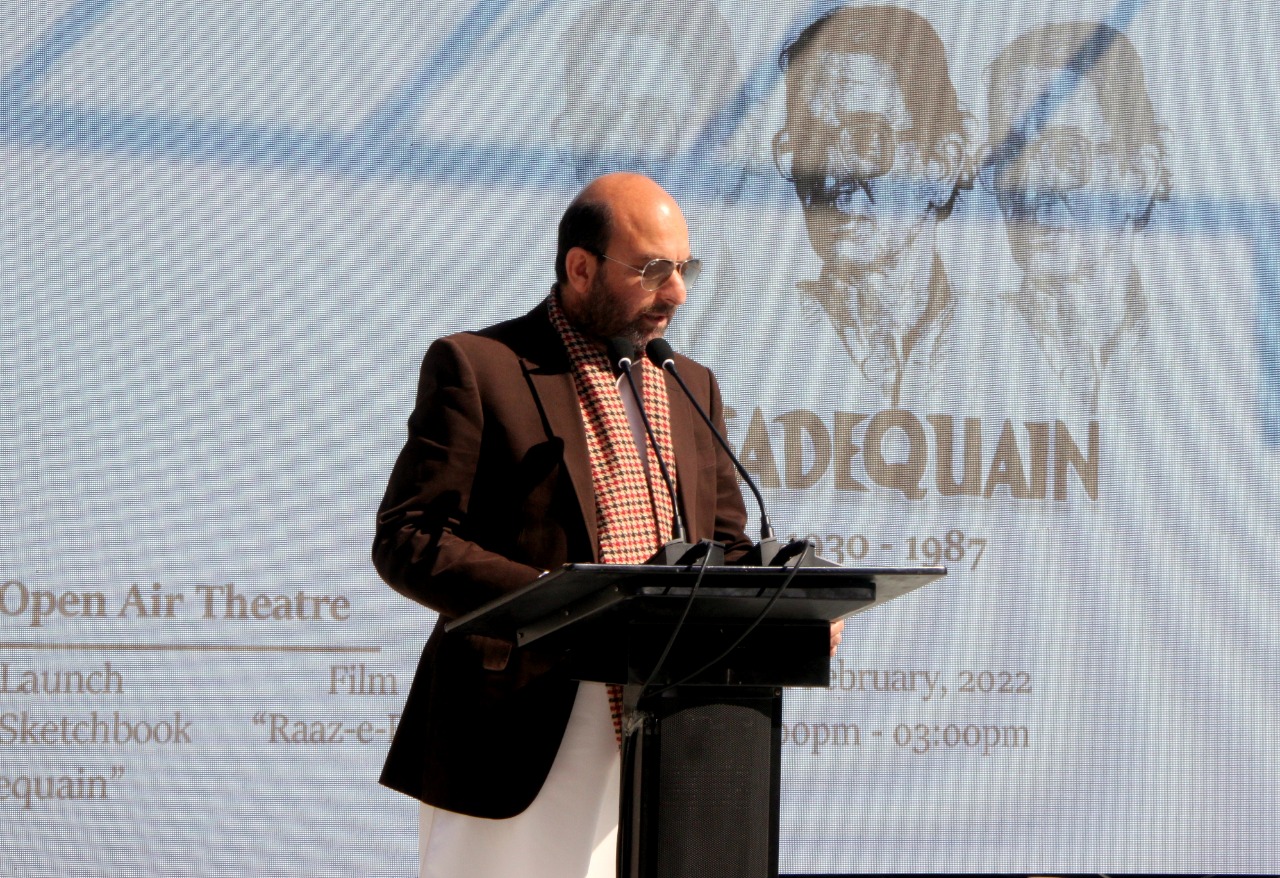
Mr. Naqvi also described the association of his maternal uncle Jaffar Naqvi, Zia Mohyeddin, and Sadequain. He used to call himself a Faqeer.
Professor Maimoona in his speech described Sadequain as an optimist and genuine artist. However, she said, it is very difficult to define Sadequain within the bounds of a few minutes. She very succinctly defined the greatness of the painter, poet, and calligrapher, saying “he was the man of his time, reflected through his artistic expressions.”
Dr. Maimoona described him a “social satirist who unveils the blatant truths of society describing the vices and virtues related to humans, without getting satirical.”
But in this process, he is always optimistic about the power possessed by man.
Many people associate morbidity with Sadequain for his excessive use of black colour and symbolism of cactus the thorny desert plant which is not much appreciated. But Sadequain reveals the heroic powers of the cactus which breaks the hard crust of the earth to emerge into the light.
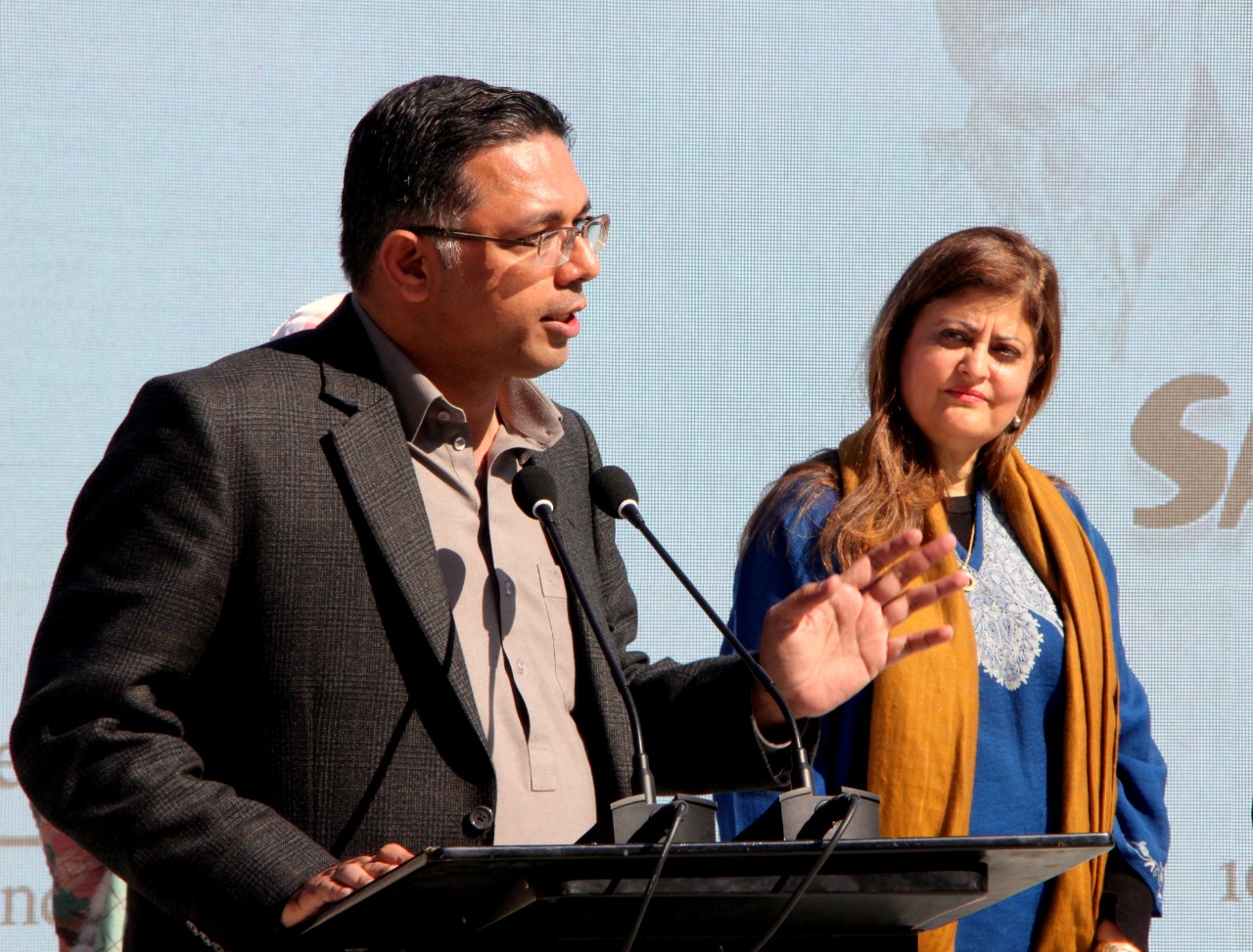 “A plant having the powers to progress against all odds is what Sadequain wants in the people of his society. He gives a sense of optimism, not morbidity,” said the professor. His expressions are very loud and bitter. As he confesses: “I am not the painter of drawing rooms, meaning his paintings are not meant to adorn elite class’s drawing rooms only.”
“A plant having the powers to progress against all odds is what Sadequain wants in the people of his society. He gives a sense of optimism, not morbidity,” said the professor. His expressions are very loud and bitter. As he confesses: “I am not the painter of drawing rooms, meaning his paintings are not meant to adorn elite class’s drawing rooms only.”
According to Professor Maimoona, Sadequain is esoteric in his approach – that can be possible only with those people who get absorbed into the inner not outer… people who decipher curves, not crusts or flakes. “His symbols are unique but deep, and prove his farsightedness – like a nest with eggs on the head of youngsters.”
Sadequain’s arabesques and calligraphic symbols look like marching troops, proceeding with drumbeats and trumpets through the colour.
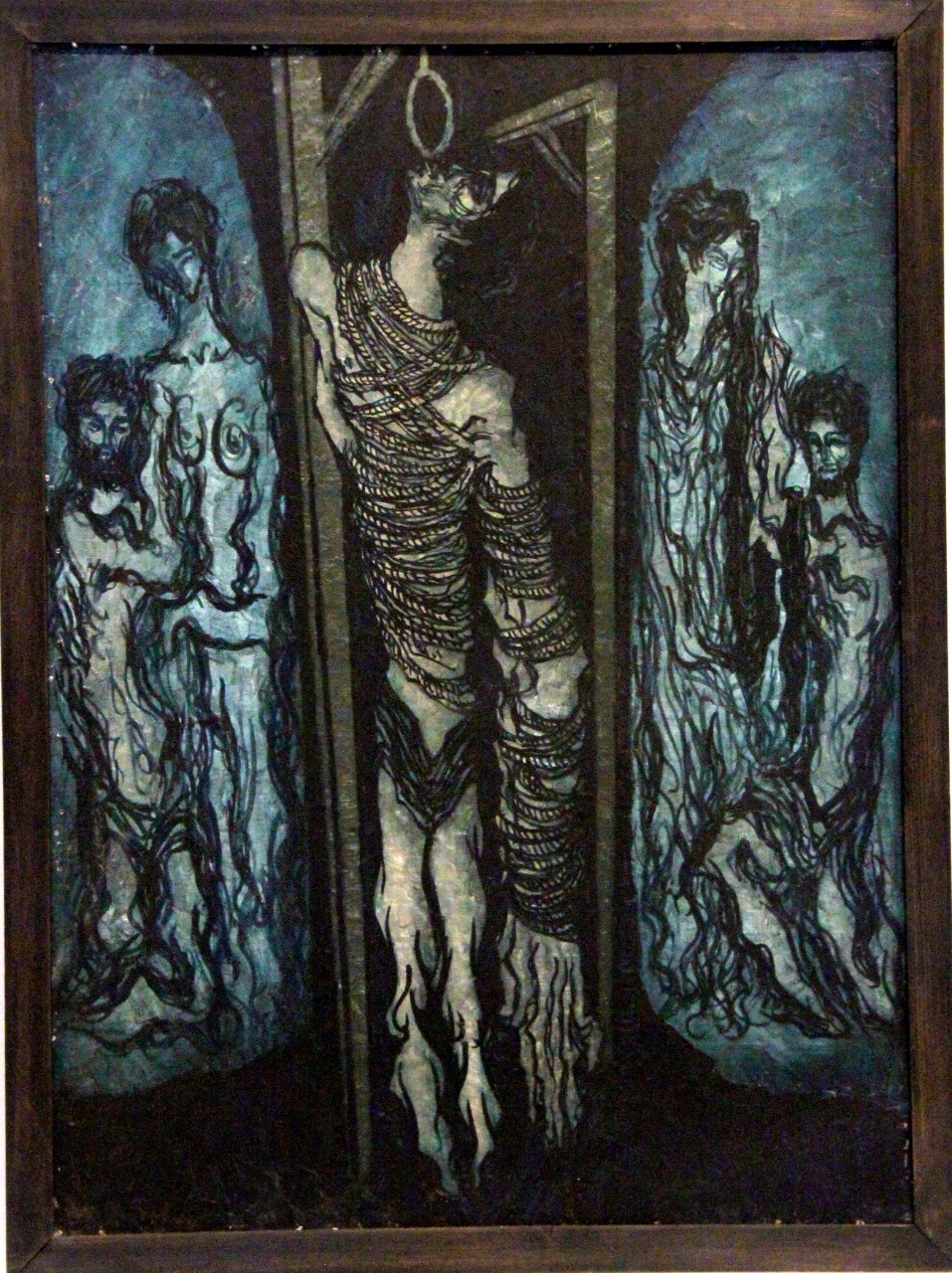 Minister of State Azfar Ahsan inaugurated the art exhibition. The paintings on display are from the National Art Gallery's permanent collection. The artist during his lifetime gifted more than 100 artworks to the PNCA.
Minister of State Azfar Ahsan inaugurated the art exhibition. The paintings on display are from the National Art Gallery's permanent collection. The artist during his lifetime gifted more than 100 artworks to the PNCA.
The primary focus of this 260-page book are the black-and-white drawings in pen and ink. These drawings were done as studies for the final set of drawings which Sadequain made to interpret his quatrains published in his book titled Rubaiyat-e-Sadequain Naqqash.
Earlier in his introductory remarks, PNCA Director General Zahir Shah welcomed the guests and spoke about Sadequain briefly.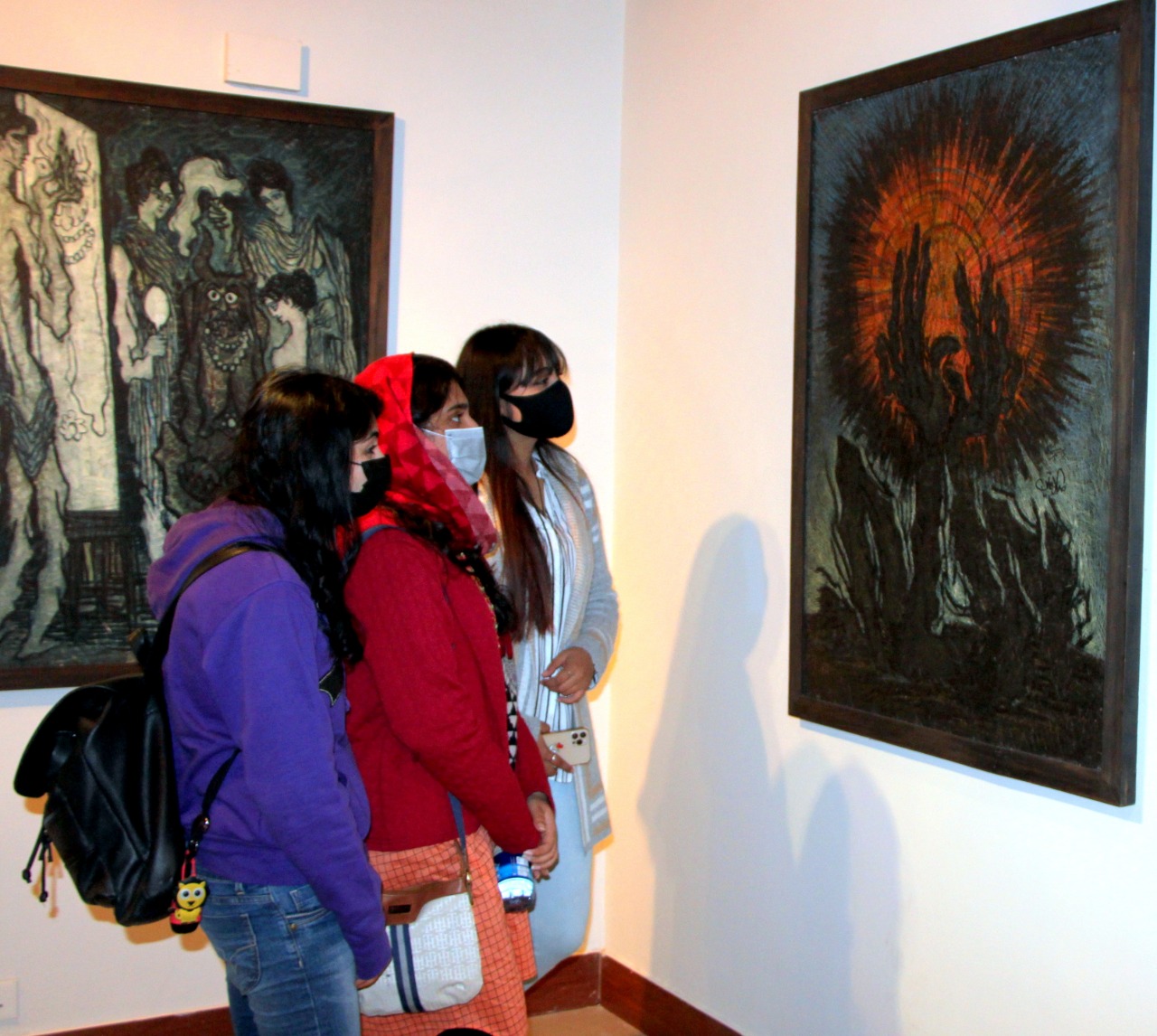
A large number of people, including members of the diplomatic community, students and socialites of the city were among the audience.
The book launch was followed by a documentary premiere.
Sadequain has been the subject of numerous documentaries, but Raaz-e-Fun stands out among all in its tone and tenor. The 30-minute film is written, narrated, and directed by the award-winning writer and director Waseem Amrohavi.
He takes the viewer on a blissful odyssey traversing Sadequain’s initial forays into calligraphy and poetry at a young age, then later in life focusing on painting and his meteoric rise on the world stage.
The film highlights the fact that even before the advent of social media, computers or even the television, Sadequain’s talent was recognized on all five continents; a fact not many Pakistanis can claim.
Amrohavi, narrating in chaste Urdu, delves into the depth of Sadequain’s genius exemplified in his murals spread over Pakistan, India, the Middle East, Europe, and America.
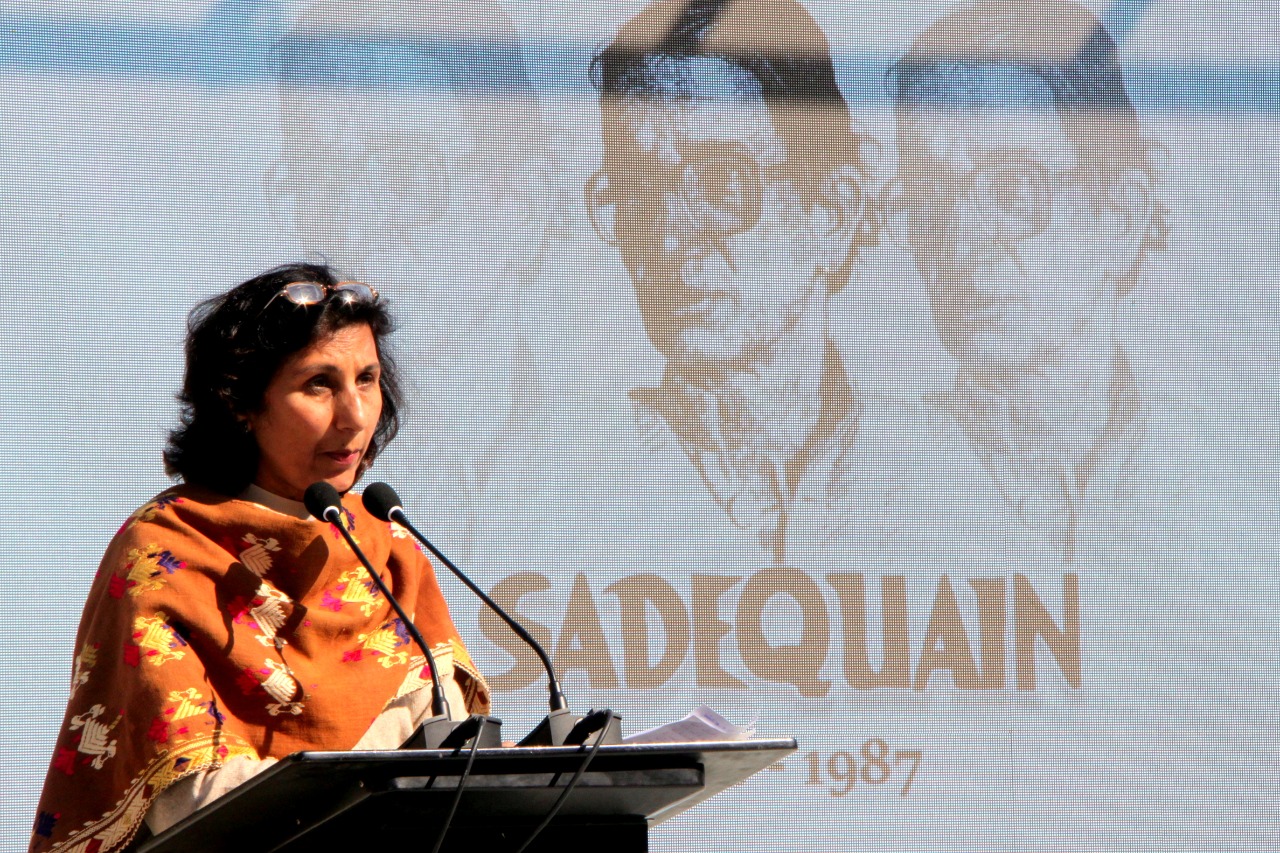 He decodes Sadequain’s mysteries shrouded in interpretations of poetry of Ghalib, Iqbal and Faiz. And he unravels the beauty and the bounty of the artist’s painterly calligraphies in what Sadequain referred to as “Khatt-e-Sadequaini” or “Sadequain’s font.”
He decodes Sadequain’s mysteries shrouded in interpretations of poetry of Ghalib, Iqbal and Faiz. And he unravels the beauty and the bounty of the artist’s painterly calligraphies in what Sadequain referred to as “Khatt-e-Sadequaini” or “Sadequain’s font.”
The docu-film shows that Sadequain in his lifetime was a celebrity and a household name in Pakistan. He gave more to the nation than any man or woman. But within a few years after he passed away, his name faded from the collective memory of the nation. He should have been the face of the nation recognized around the globe, but sadly, he became a stranger in his own country; an unsung hero.
Established in 2007, the Sadequain Foundation is a not-for-profit organisation dedicated to discovering, preserving, and promoting Sadequain’s art globally. To that end, the Foundation has published 25 books on Sadequain’s life and work, and curated more than 100 seminars and exhibitions around the globe, resulting in resurrection of Sadequain from obscurity.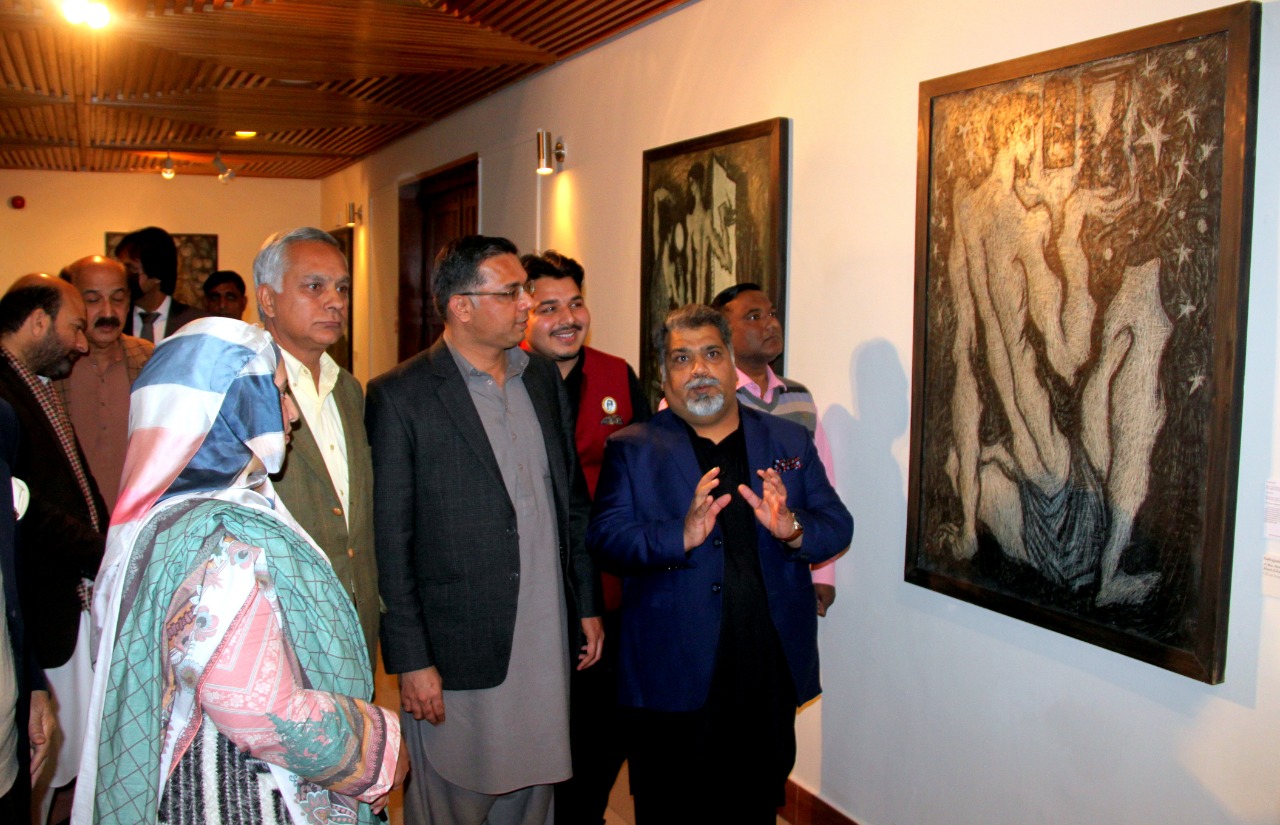
Dr. Salman Ahmad is an electrical engineer by profession. He founded the SADEQUAIN Foundation in June 2007 to catalog Sadequain’s work and introduce it to the world. He has authored 24 books on Sadequain including SADEQUAIN-ISM 201, The legend of SADEQUAIN – Renaissance of Calligraphic Art, SADEQUAIN: Strokes of Picasso - Scale of Michelangelo, Mystic Expressions by SADEQUAIN – An Odyssey to Exaltation with Ghalib, Iqbal, Faiz, and Sadequain, Realism to Calligraphic, Cubism – The Legacy of SADEQUAIN from Paris to Pakistan, Ghalib and Sadequain (in Hindi), Trails of the Lost Art of Sadequain and The Saga of SADEQUAIN. There are many more books in the pipeline.
Sadequain passed away during the night of February 10th, 1987, at O.M.I. Clinic in Karachi.
Before Sadequain was buried, reportedly some 300 of his paintings were robbed from the storage in Frere Hall, where he had been working on the ceiling mural titled Arz-o-Samawaat.
This was the gist of the speeches that were made by participants at an event featuring the launch of a book from the sketchbook of Sadequain, an exhibition of his paintings and calligraphy titled "Mystic Expressions” and the screening of a docu-film Raaz-e-Fun on the life and achievements of the legendary artist.
 The event was organised by the Pakistan National Council of the Arts (PNCA) in collaboration with the Sadequain Foundation on his 35th anniversary on Thursday.
The event was organised by the Pakistan National Council of the Arts (PNCA) in collaboration with the Sadequain Foundation on his 35th anniversary on Thursday.Minister of State and BoI Chairman Zafar Ahsan opened the show along with former Ambassador Sarwar Naqvi and Professor Dr Maimoona Khan.
Ali Sarwar Naqvi, a former Ambassador to the US and currently working as the founding executive director of the Centre for International Studies, highlighted the artist’s greatness and achievements. He recalled his fond memories when he met the artist as a student at Karachi in the late 1960s.
He described Sadequain as an icon, a cult personage who has a devoted following even today and will continue to have for years to come.
“He lives in our memories and in our thoughts,” said Mr Naqvi.
Sadequain was the most prolific painter and poet of his time. He was compared to Picasso for the versatility and vigour of his artistic genius and to Michelangelo for his gigantic murals displayed on many public buildings. No other Pakistani artist has created such huge murals. “Like Picasso, Sadequain had a signature to his arts. He was much decorated and honoured in Pakistan and abroad,” veteran diplomat Mr. Naqvi noted. “He was such a master of the traditional art of calligraphy that he raised to an art form of his own style. Unlike many other painters and calligraphers.”

Mr. Naqvi also described the association of his maternal uncle Jaffar Naqvi, Zia Mohyeddin, and Sadequain. He used to call himself a Faqeer.
Professor Maimoona in his speech described Sadequain as an optimist and genuine artist. However, she said, it is very difficult to define Sadequain within the bounds of a few minutes. She very succinctly defined the greatness of the painter, poet, and calligrapher, saying “he was the man of his time, reflected through his artistic expressions.”
Dr. Maimoona described him a “social satirist who unveils the blatant truths of society describing the vices and virtues related to humans, without getting satirical.”
But in this process, he is always optimistic about the power possessed by man.
Many people associate morbidity with Sadequain for his excessive use of black colour and symbolism of cactus the thorny desert plant which is not much appreciated. But Sadequain reveals the heroic powers of the cactus which breaks the hard crust of the earth to emerge into the light.
 “A plant having the powers to progress against all odds is what Sadequain wants in the people of his society. He gives a sense of optimism, not morbidity,” said the professor. His expressions are very loud and bitter. As he confesses: “I am not the painter of drawing rooms, meaning his paintings are not meant to adorn elite class’s drawing rooms only.”
“A plant having the powers to progress against all odds is what Sadequain wants in the people of his society. He gives a sense of optimism, not morbidity,” said the professor. His expressions are very loud and bitter. As he confesses: “I am not the painter of drawing rooms, meaning his paintings are not meant to adorn elite class’s drawing rooms only.”According to Professor Maimoona, Sadequain is esoteric in his approach – that can be possible only with those people who get absorbed into the inner not outer… people who decipher curves, not crusts or flakes. “His symbols are unique but deep, and prove his farsightedness – like a nest with eggs on the head of youngsters.”
Sadequain’s arabesques and calligraphic symbols look like marching troops, proceeding with drumbeats and trumpets through the colour.
 Minister of State Azfar Ahsan inaugurated the art exhibition. The paintings on display are from the National Art Gallery's permanent collection. The artist during his lifetime gifted more than 100 artworks to the PNCA.
Minister of State Azfar Ahsan inaugurated the art exhibition. The paintings on display are from the National Art Gallery's permanent collection. The artist during his lifetime gifted more than 100 artworks to the PNCA.The primary focus of this 260-page book are the black-and-white drawings in pen and ink. These drawings were done as studies for the final set of drawings which Sadequain made to interpret his quatrains published in his book titled Rubaiyat-e-Sadequain Naqqash.
Earlier in his introductory remarks, PNCA Director General Zahir Shah welcomed the guests and spoke about Sadequain briefly.

A large number of people, including members of the diplomatic community, students and socialites of the city were among the audience.
The book launch was followed by a documentary premiere.
Sadequain has been the subject of numerous documentaries, but Raaz-e-Fun stands out among all in its tone and tenor. The 30-minute film is written, narrated, and directed by the award-winning writer and director Waseem Amrohavi.
He takes the viewer on a blissful odyssey traversing Sadequain’s initial forays into calligraphy and poetry at a young age, then later in life focusing on painting and his meteoric rise on the world stage.
The film highlights the fact that even before the advent of social media, computers or even the television, Sadequain’s talent was recognized on all five continents; a fact not many Pakistanis can claim.
Amrohavi, narrating in chaste Urdu, delves into the depth of Sadequain’s genius exemplified in his murals spread over Pakistan, India, the Middle East, Europe, and America.
 He decodes Sadequain’s mysteries shrouded in interpretations of poetry of Ghalib, Iqbal and Faiz. And he unravels the beauty and the bounty of the artist’s painterly calligraphies in what Sadequain referred to as “Khatt-e-Sadequaini” or “Sadequain’s font.”
He decodes Sadequain’s mysteries shrouded in interpretations of poetry of Ghalib, Iqbal and Faiz. And he unravels the beauty and the bounty of the artist’s painterly calligraphies in what Sadequain referred to as “Khatt-e-Sadequaini” or “Sadequain’s font.”The docu-film shows that Sadequain in his lifetime was a celebrity and a household name in Pakistan. He gave more to the nation than any man or woman. But within a few years after he passed away, his name faded from the collective memory of the nation. He should have been the face of the nation recognized around the globe, but sadly, he became a stranger in his own country; an unsung hero.
Established in 2007, the Sadequain Foundation is a not-for-profit organisation dedicated to discovering, preserving, and promoting Sadequain’s art globally. To that end, the Foundation has published 25 books on Sadequain’s life and work, and curated more than 100 seminars and exhibitions around the globe, resulting in resurrection of Sadequain from obscurity.

Dr. Salman Ahmad is an electrical engineer by profession. He founded the SADEQUAIN Foundation in June 2007 to catalog Sadequain’s work and introduce it to the world. He has authored 24 books on Sadequain including SADEQUAIN-ISM 201, The legend of SADEQUAIN – Renaissance of Calligraphic Art, SADEQUAIN: Strokes of Picasso - Scale of Michelangelo, Mystic Expressions by SADEQUAIN – An Odyssey to Exaltation with Ghalib, Iqbal, Faiz, and Sadequain, Realism to Calligraphic, Cubism – The Legacy of SADEQUAIN from Paris to Pakistan, Ghalib and Sadequain (in Hindi), Trails of the Lost Art of Sadequain and The Saga of SADEQUAIN. There are many more books in the pipeline.
Sadequain passed away during the night of February 10th, 1987, at O.M.I. Clinic in Karachi.
Before Sadequain was buried, reportedly some 300 of his paintings were robbed from the storage in Frere Hall, where he had been working on the ceiling mural titled Arz-o-Samawaat.

